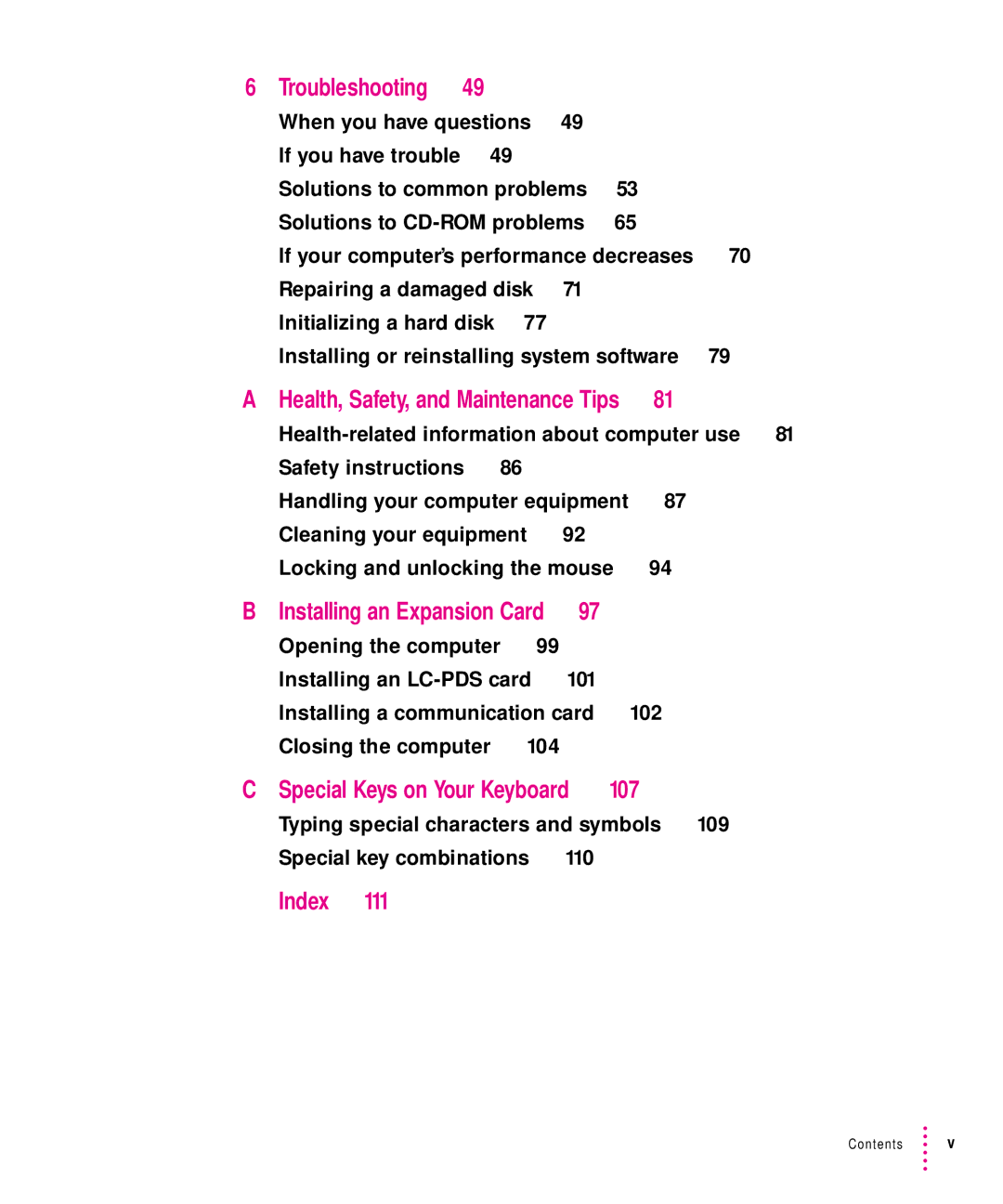Contents
User’sGuide
Apple Computer, Inc
Contents
Getting Help
Connecting Additional Equipment
Index 111
Troubleshooting
Communications regulation information
DOC statement
Page
Welcome to Macintosh
Monitor
Plugging in the computer
Getting Started
Choose a power outlet to which you have easy access
Connecting the monitor power cord
Installing an expansion card
Connecting a monitor
On some monitors, the cord is already attached
Connecting the monitor cable
Connecting the mouse and keyboard
ADB port
Turning the computer on
Connecting other equipment
Check to see what’s on your screen
Problems starting up?
What’s next?
Learning the basics
To find an answer to a question, look in the Guide h menu
Reviewing the basics
Turning the computer off
User’s Guide
Where to find answers
Page
Getting Help
Getting answers to your questions
Getting answers with the Topics button
Now continue with the next section
Getting answers with the Index button
Read and follow the instructions in the window
Getting answers with the Look For button
If you want to close Macintosh Guide, click here
Tips for using Macintosh Guide
Identifying objects on the screen
Main Macintosh Shortcuts window appears
Learning useful shortcuts
Chapter
Connecting Additional Equipment
Video input card optional
Where to connect additional equipment
Connecting an Apple PlainTalk Microphone
Connecting external stereo speakers
Expanding memory
Connecting to an Ethernet network
Installing internal drives
Using Programs and Backing Up Disks
Installing application programs
Finding out which programs are open
Switching programs
Working with several programs at a time
Hiding and showing windows on the desktop
Making backup copies of the documents you create
Protecting the information on a disk
Special memory requirements
Using older Macintosh programs
Restoring the information on your hard disk
Page
Using the CD-ROM Drive
Inserting a CD-ROM disc
If no CD-ROM disc icon appears on your screen
Ejecting a CD-ROM disc
Standard file formats
Types of compact discs you can use
Other CD-ROM formats
Audio CDs
Photo CDs
Playing audio CDs
Working with Photo CDs
Obtaining Photo CDs
Before viewing the contents of a Photo CD
Sharing a CD-ROM disc over a network
If you have trouble
Troubleshooting
When you have questions
Take your time
Start over
Rebuild your desktop regularly
Solutions to common problems
Chapter
Sad Macintosh icon appears and the computer won’t start up
Hard disk icon does not appear on the desktop
Your Macintosh can’t read a floppy disk
You see a message that you need to have an FPU installed
Dialog box with a bomb appears
Pointer 8 doesn’t move when you move the mouse
Typing on the keyboard produces nothing on the screen
Chapter
You experience problems using a document from a DOS computer
You experience problems using an older Macintosh program
Problems using the CD-ROM drive
Solutions to CD-ROM problems
Problems with CD-ROM discs
Problems using ISO 9660 or High Sierra discs
Problems playing audio CDs
Problems using Photo CDs
If your computer’s performance decreases
Try these suggestions first
Repairing a damaged disk
If you see a blinking question mark on your screen
Starting up from a CD-ROM disc
If you see the Macintosh desktop
Problems starting up from the CD?
Checking for damage on your hard disk
How to repair a hard disk or floppy disk
Initializing a hard disk
If Disk First Aid cannot correct the problem
List of drives, click the disk you want to initialize
When should you install or reinstall system software?
Installing or reinstalling system software
Page
Health-related information about computer use
Appendix a Health, Safety, and Maintenance Tips
Musculoskeletal discomfort
Arranging your office
Eye fatigue
Thighs horizontal
What about electromagnetic emissions?
Avoiding fatigue
Safety instructions
Handling your computer equipment
Handling the keyboard
Handling the monitor
Handling CD-ROM discs
Handling floppy disks
To avoid damage to your discs, keep these points in mind
If you can’t eject a floppy disk
Ejecting a disk
Power supply
Cleaning your equipment
Cleaning the computer case
Cleaning the monitor
Rotate the rollers to clean all around them
Recessed area on ring Recessed area surrounding ring
Locking and unlocking the mouse
To unlock the mouse, follow these steps
Page
Appendix B Installing an Expansion Card
Appendix B
Opening the computer
Appendix B
Align the card over the LC-PDS slot
Installing an LC-PDS card
Installing a communication card
Communication slot is the rightmost slot on the logic board
Closing the computer
If you removed security screws earlier, reinsert them now
Your computer is now ready to turn on and use
Special keys on Apple keyboards Arrow keys
Appendix C Special Keys on Your Keyboard
Control key
Typing special characters and symbols
Key combination
Special key combinations
Index
Index
Index
Index
Index
Index
Index
Macintosh Performa CD 38, 39. See also CD-ROM disc
Index
Index
Index
Index
Y, Z
Apple Computer, Inc
